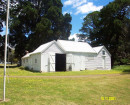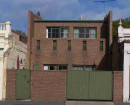Toora Avenue of Honour
Welshpool Road TOORA, South Gippsland Shire
-
Add to tour
You must log in to do that.
-
Share
-
Shortlist place
You must log in to do that.
- Download report
Statement of Significance
What is Significant?
The Toora Avenue of Honour, planted in 1920 & 1933, at Foster, Welshpool and Grip Roads, Toora.
Why is it Significant?
The Toora Avenue of Honour is of local historic, aesthetic and social significance to the town and district of Toora.
Historically, it is important as one of a series of similar memorial avenues that were established throughout the Shire, and expresses the significant effect that the First World War had upon small rural communities. (AHC criteria - A.4 and D.2) Aesthetically, the Avenue enhances the appearance of the South Gippsland Highway and Grip Road and provides an appropriate visual setting for the World War 1 memorial situated at the intersection with Stanley Street. (AHC criterion - E.1) Socially, the Avenue is important as a memorial to local residents who served in World War 1 and contributes to the identity of Toora. (AHC criterion - G.1)
-
-
Toora Avenue of Honour - Physical Description 1
The Toora Avenue of Honour comprises a double row of Mahogany Gums planted along Welshpool and Foster Roads (South Gippsland Highway), and also the same species planted on either side of Grip Road. (formerly known as Piggery Lane)
Toora Avenue of Honour - Physical Description 2
Style
Honour Avenue
Toora Avenue of Honour - Historical Australian Themes
Thematic Context
Government + Community Institutions
Sub-Themes
Military Defence
Veterans Description for Public
Toora Avenue of Honour - Veterans Description for Public
The Toora Avenue of Honour comprises of a double row of Mahogany Gums planted along Welshpool and Foster Roads (South Gippsland Highway), and also the same species planted on either side of Grip Road (formerly known as Piggery Lane). It is believed that the Avenue was originally planted in 1920 in Welshpool Road (then known as Rotton Row) and was extended to Grip Road (then known as Piggery Lane) in 1933. The planting of the Avenue was discussed at a meeting of the Toora Progress Association on 10th July 1919 where on the motion of FR Fretwell and Secretary it was decided to "bring before the public the need for their co-operation in having a row of trees planted along Rotton Row as an Avenue of Honour." In 1933, the Toora Branch of the Australian Natives Association requested that Council extend the Avenue as far as Piggery Lane. As of 2011, the trees were in a poor condition.
In Australia, commemorative trees have been planted in public spaces since the late nineteenth century. Arbor Days were held regularly in most Victorian State Schools during the late 1800s and early 1900s, and numerous trees were planted in parks in Melbourne and throughout Victoria to mark the visits of important and famous people.
This tradition of commemorative planting was continued in 1901 when at the end of the Boer War trees were often planted for each soldier of the district who was killed in South Africa. These plantings, however, rarely consisted of more than two or three trees in each town.
During and after the First World War avenues of honour consisting of trees lining significant streets became a popular form of commemoration. They represented a new egalitarian approach to the commemoration of soldiers where rank was not a consideration: each tree symbolises a person.
Avenues of honour are a uniquely Australian phenomenon. Australians, and in particular Victorians, embraced the idea of planting them more enthusiastically than any other country in the world. Dating from May 1916, the Eurack Avenue of Honour is the earliest known avenue of honour to be planted in Victoria.
By the time of the Second World War avenues of honour had declined in popularity as a means of commemoration. Today it is estimated that over 300 avenues of honour have been planted in Victoria to commemorate service personnel since 1901.
Heritage Study and Grading
South Gippsland - South Gippsland Heritage Study
Author: David Helms with Trevor Westmore
Year: 2004
Grading:
-
-
-
-
-
TOORA REALIGNMENT H3 TRAMWAY
 Victorian Heritage Inventory
Victorian Heritage Inventory -
ST THOMAS' ANGLICAN CHURCH & PARISH HALL
 South Gippsland Shire
South Gippsland Shire -
ST AGNES' CATHOLIC CHURCH
 South Gippsland Shire
South Gippsland Shire
-
10 Down Street
 Yarra City
Yarra City
-
-











